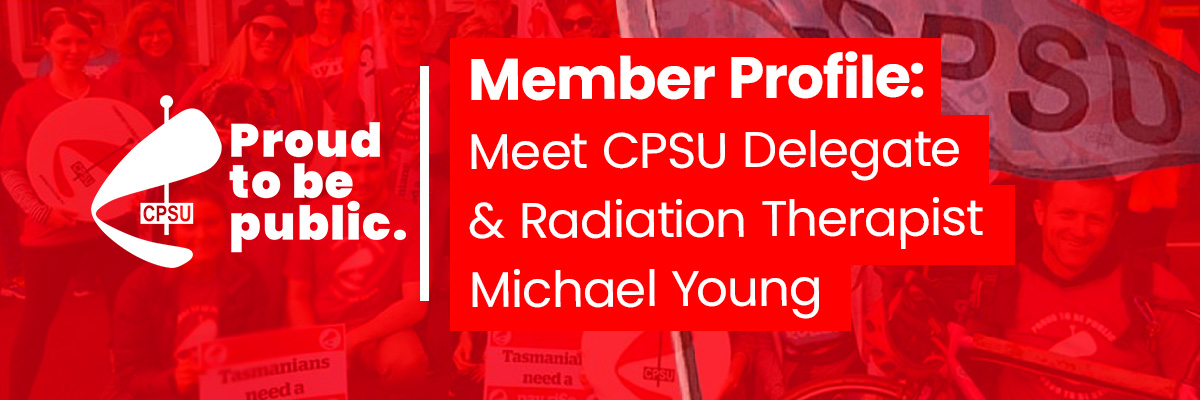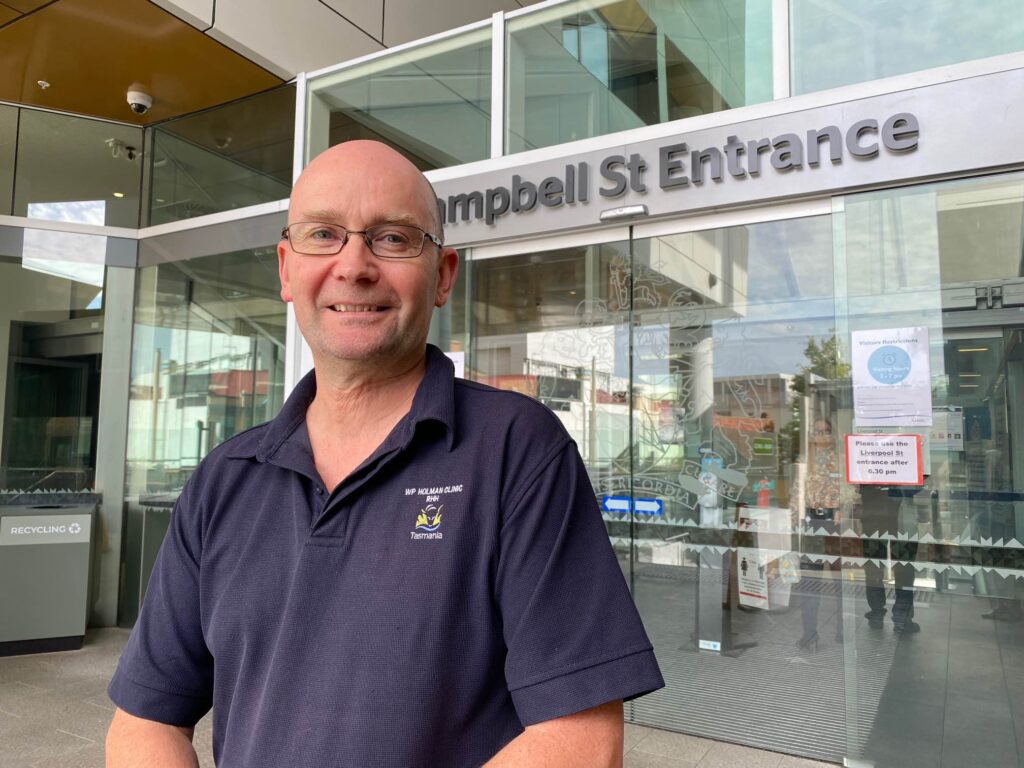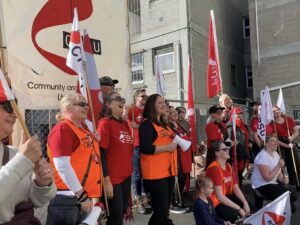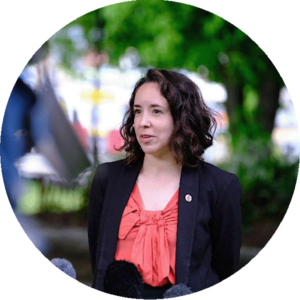
Who are Radiation Therapists and what do they do? We heard from CPSU Delegate Michael Young about the lifesaving work these Tasmanians carryout and why we need to urgently address the recruitment and retention crisis these Allied Health Professionals are facing.

What does a Radiation Therapist do?
Radiation Therapists design and deliver radiation treatments for cancer patients using specialised equipment and computer systems. The process involves several steps, starting with a planning CT scan with the patient in the position they are going to be treated. This and other imaging (MRI, PET scans etc) are used to delineate the area that needs to be treated and healthy tissues that should be avoided. An individualised radiation plan is designed considering each patient’s unique anatomy and treatment requirements. The treatment for most patients is then delivered via a high energy x-ray machine (linear accelerator or linac for short). Radiation Therapists take pre-treatment images (x-rays or CT scans) to ensure the patient set-up is accurate (to the millimetre) and decide if OK to proceed or if adjustments are needed before we deliver the treatment. We monitor our patients for any side-effects or other issues and work closely with Radiation Oncologists (who prescribe the treatment dose/area), Radiation Oncology Medical Physicists, Nursing and other members of the multi-disciplinary team. There are public centres in Hobart, Launceston and Burnie – planning and treatment is free/bulk-billed (unlike in the private sector where patients can be charged significant out of pocket costs for exactly the same treatment).
What do you love about your job?
For me personally I love the technology which has changed dramatically throughout my career. We’re continually implementing quality improvements in accuracy, different complex treatment techniques and our ability to treat patients more effectively and minimise any side-effects. A recent example of this is ‘Respiratory Monitoring’ where we can account for breathing motion to treat lung cancers more accurately or reduce dose to the heart for left-sided breast cancer patients. In 2020/2021 we implemented a new state-wide Treatment Planning computer system which has been a game changer for us. It, along with new CT scanners and treatment machines, has meant we can expand the techniques we can deliver (for example, for tiny brain tumours preventing the need for patients to travel to the mainland for treatment) and do so more efficiently. Then there’s also the patient care aspect which is a big component of the job – at the end of the day we’re treating patients and they’re central to everything we do.
You must be meeting people at a really difficult time in their lives, is this a hard part of the job?
We are confronted with some sad scenarios, particularly when treating people towards the end of their life. That’s where the caring and compassionate nature of all our team come to the fore. Patients can be on treatment for up to 8 weeks, so we really get to know them and build a good rapport and support them through their cancer journey. I am glad to say the vast majority of patients have very good outcomes/success rates, but even if someone is really unwell and undergoing palliative treatment we can help alleviate symptoms and keep them comfortable.
What does the recruitment and retention crisis mean for workers?
We have Radiation Therapy vacancies across the state. This means that we can’t implement some of the new advancements that we’d like to, or our workload increases such that it impacts patient wait times which can impact their outcome. In Burnie for example, they have a brand new linac (worth approx. $3M) sitting idle as they’ve had staff resign and been unable to replace them. At the same time demand/number of patients has been increasing which means longer hours for the staff remaining, or patients waiting longer for treatment.
Why do you think there is such a crisis?
There are several factors at play here. There’s been a lack of workforce planning nationally and the number of students graduating has reduced by about 30%. We’re also a niche profession that not many people know about until they actually need our type of treatment. Tasmania doesn’t have its own training course, so we rely on students to come to Tassie to learn and hopefully return. We give them great learning opportunities, they have a great time and have often come back to work in Tassie, but numbers recently have been low and competition for both new graduates and experienced staff is fierce. There’s been big pay rises interstate which has made it much harder to attract and retain staff, and, as we’re all feeling, the cost of living has gone up dramatically across the state. Housing is no longer the bargain it once was compared to the mainland. Population growth is part of that story which feeds directly into demand for our services.
What does it mean for Tasmanians needing cancer treatment and their families?
As mentioned above it mean delays in starting their treatment. Time is critical and directly impacts outcomes. We have fantastic infrastructure, equipment and state-of-the-art techniques and technology that cannot be fully utilised if we don’t have adequate staffing.
What do you think we need to help address this crisis?
The government needs to get serious and offer Radiation Therapists a comprehensive package that makes Tasmania an attractive place to work and live.
How have you found negotiations so far?
Frustrating! We feel like we’ve been forgotten or lost in the other negotiations. Other AHPs have negotiated an interim offer including backpay to December yet Radiation Therapists have received nothing. The most recent ‘offer’ indicates the government negotiators have little idea about who we are or the critical nature of our work.
Why did you become a CPSU Delegate?
It was suggested by our previous workplace delegate very early on in my career. I was interested in representing my colleagues and jumped at the chance.
What do you enjoy about this union role?
I’ve been involved in several rounds of negotiations including for the initial Radiation Therapists agreement that we achieved some years ago. Representing my colleagues and having input on those discussions has resulted in some positive outcomes for RTs such as getting Radiation Therapy Educator roles as part of our establishment to support our continuous training needs.

Varia Truebeam Linear Accelerator – we have 5 in the state with a 6th being installed at RHH later this year which will replace an older model machine

Example Stereotactic Lung Plan – Shaded green area is target volume. Dose lines (Gy) surrounding target and fall-off (reduce) rapidly minimising dose to healthy tissue. Stereotactic treatments like this have increased exponentially since we first introduced them in 2015. They allow treatment to be delivered in 1-4 treatments vs up to 30 visits for conventional radiotherapy treatment.

Example Stereotactic Brain Plan – This patient has two tumours. The goal is to deliver high dose to the tumours and minimise normal healthy brain dose. Research shows that there is less impact on cognition/memory and longer survival for patients receiving stereotactic treatment compared to conventional (whole brain) treatment. Before COVID patients needed to travel to Melbourne for this type of treatment. Over the last 3 years we have implemented and refined this technique at the RHH.









